The bodies of the two men who perished in Saturday’s crash of a Trans Guyana Airways (TGA) plane in the middle Mazaruni jungle were retrieved and brought to the city yesterday even as company officials expressed concern that the aircraft’s Emer-gency Locator Transmitter (ELT) was not triggered on impact.
“We pledge to do everything possible to determine the cause of this accident. We are fully cooperating with the local civil aviation authorities and we will request whatever international assistance may be required,” Chief Executive Officer of the Correia Group of Companies, Michael Correia told a news conference yesterday. TGA is part of the Correia Group.
An investigation is underway to determine the cause of the accident and company executives declined to comment on any probable cause.
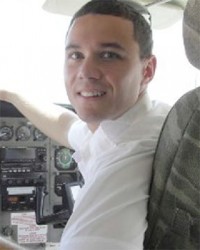
Pilot Blake Slater and cargo loader Dwayne Jacobs died in the crash. The craft went missing on Saturday morning while transporting mining supplies from Olive Creek to Imbaimadai. TGA spokesman Kit Nascimento had told Stabroek News that the plane, a Cessna 208B Grand Caravan which bore registration number 8R-GHS, went down shortly after take-off from the small Olive Creek airstrip in the mountainous, jungle area in Region Seven.
Nascimento said that at 10:55 am, shortly after the plane’s take-off from the airstrip, a distress call was received from the pilot. He said that the airline immediately launched a full search and rescue operation using a plane that was in the area at the time. The Guyana Civil Aviation Authority (GCAA) was also notified and activated its Rescue Coordination Centre and additional planes, two helicopters and army personnel were deployed to the area. After hours of searching, the crash site was identified on Sunday just after noon. Soldiers reached the site on Monday and the bodies were retrieved and brought to the city yesterday.
“We shared in the frustration experienced over the length of time that it took to locate the aircraft in the first place. It took a little over 24 hours. And the frustration over the time it took to complete the recovery and extraction…,” Correia said.
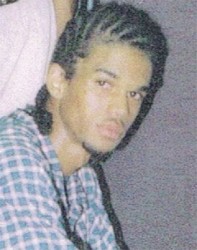
The plane was equipped with an ELT but it was not triggered. ELTs are emergency transmitters that are carried aboard most general aviation aircraft and, in the event of an aircraft accident, the devices are designed to transmit a distress signal on certain frequencies, making it easy to determine the exact location of the aircraft.
The company’s Director of Maintenance John Isaacs declined to comment on possible reasons as to why the ELT was not triggered, noting that it will form part of the investigation but Correia said that this is a concern because the devices are designed to pinpoint a location.
“Several of these ELTs have not gone off in prior accidents so this is something that is gonna be of great concern to us,” he said. The CEO revealed that the company uses the “most current” Artex 406 ELTs, which was recommended by the International Civil Aviation Organisation (ICAO). He added that in 2009, the company changed from a “less accurate” ELT to the current one which is supposed to be a lot more accurate. The problem, which the experts have to determine, he said, “is that they are not triggered in even a fairly horrific accident like what we have so that’s obviously a big concern.”
An industry concern
Correia said that most of the local aircraft have this type of ELT and it is going to be an industry concern that has to be addressed and not only here as the devices are not manufactured locally. He said that
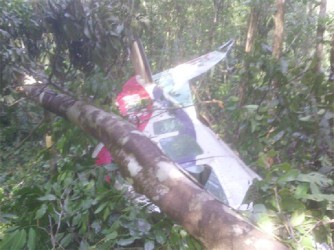
there were incidents before where the ELT did not go off. “It is something that our organisation will be looking at in future but it has to be done in conjunction with the civil aviation authority” and would probably form part of their investigation, he said, even as he pointed out that other members of the industry have expressed concern.
The CEO emphasised that the plane had additional equipment, such as spot trackers onboard that helped searchers to zoom in on the possible location. But the ELT would give a more precise location, he noted.
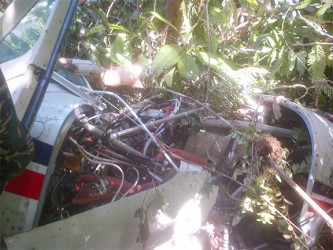
In recounting the incident, Correia said that on Saturday, at approximately 10:55am, Slater radioed a distress signal that was heard by five pilots, including three TGA pilots who were flying at the time. “Captain Blake Slater called out “mayday” as he was going down and attempted to relay his coordinates. He was successful in giving us half of the required coordinates. One of our aircraft, Captained by Prem Ramdhanie, immediately flew to the area in which he went down and commenced search[ing] within 15 minutes of the distressed call being received,” he said. The TGA official noted that air traffic control was notified and the national search and rescue team was immediately activated. Two helicopters and two fixed wing aircraft were used for the search.
Correia, who was part of the search team, said that they were dealing with an almost impenetrable jungle. In the recovery and extraction, the team was confronted with an unforgiving and extremely hostile terrain, with jungle that has trees in excess of 200 feet high and weather conditions that moved in waves which continually hampered their efforts, he said.
Correia thanked the Guyana Defence Force team for its professionalism and courage in going into the jungle at night to locate the aircraft. “They’re fearless,” he said, adding that when the wreckage was spotted, they had to find a spot where they could get them as close as possible to the aircraft as the helicopter couldn’t land. “They actually had to jump in a clearing and then make their way to the aircraft during the night. These guys are very good and very brave,” he said.
Prior to the crash, the plane had done six shuttles from Olive Creek and there were no reports of technical problems, according to the officials. On the fateful flight were seven drums of diesel weighing about 2800 pounds, below the maximum allowable cargo weight of just under 3000 pounds. The bodies of the men were crushed but there is no requirement to have cargo walls on such aircraft, according to Correia.
Apart from the GCAA investigation, the company will also be doing its own probe and will be requesting international assistance likely from the Caribbean Aviation Safety and Security Oversight System (CASSOS) and the plane’s engine manufacturer. TGA has operated Cessna Caravans for 17 years and this is the first accident they have had with this plane, Correia said. “This is a huge problem for us,” he emphasised. The plane underwent complete maintenance on Decem
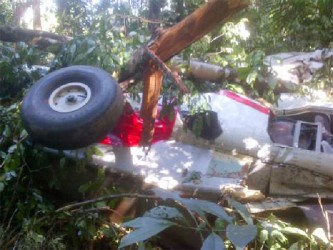
ber 30 and a safety inspection on January 7, officials said.
More helicopters needed for search and rescue
Meanwhile, the need for more helicopter support as well as other technologies for search and rescue operations was also highlighted. Correia noted that the plane went straight through the trees and there was just a small opening from which it could be seen only from one angle. “I was flying over it all the time on a fixed wing aircraft; because the aircraft was so fast it’s very difficult for you to actually spot an aircraft under those conditions. It reinforces the need for helicopters in search and rescue operations,” he said.
“If we didn’t have helicopters we probably would have had difficulty actually finding the (aircraft) even though we knew where it was because the search radius wasn’t like a big area, it was like just three miles which is not a huge distance for an aircraft,” he added.
In terms of accessing a crash site quickly, Correia said that firstly, it must be ensured that there is no possibility of the ELT not working in a crash situation. Secondly, he said: “we have to have helicopters involved in search and rescue operations and the use of a more powerful helicopter would be very helpful.”
He said that the GDF soldiers were not able to rappel down using the smaller helicopters because they are not powerful enough. Such operations are high risk and a much more powerful helicopter would be very helpful. The GDF Bell 412 is the helicopter that would help in this regard, he said. In addition, Chief Executive Officer of Ogle Airport Incorporated (OAI) Anthony Mekdeci said that there were other technologies, such as infrared devices that could detect downed aircraft faster.
The wreckage remains under the control of the GCAA and removal would have to be coordinated with them. The TGA officials could not give a timeline for the completion of the investigation, saying that this is within the remit of the GCAA.
Chief Finance Officer of the Correia Group Nicole Correia said that discussions with the families on compensation will be done. They will be taken care of, Michael Correia assured adding that the two men and the aircraft were fully insured. “Our people are well insured and we have more than one insurance coverage for both these individuals,” he said.
Correia said that Jacobs joined TGA as a handyman on 26th July, 2004, and, as a result of his dedication to his job, he was promoted to Aircraft Loader, a position of considerable responsibility for the safety and security of the cargo. Slater joined the company three years ago as a Junior Pilot and became a Command Pilot on the Cessna Grand Caravan in April last year. He was born in Canada but his mother is Guyanese. He has a total of over 3,000 flying hours to his credit and 2,552 on the Caravan. He has enjoyed the reputation of being a thoroughly disciplined pilot, he said.
“We are working with the families of both boys and will do everything that is needed to be done to support them,” Correia said.





